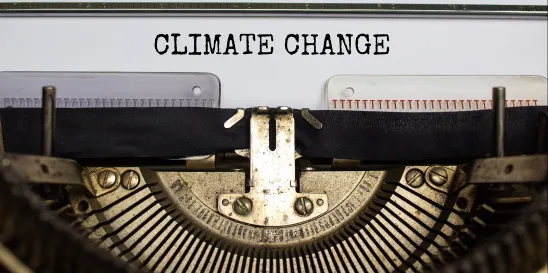As we enter 2024, we once again1 review the most significant legislation, policy changes and regulatory actions with respect to climate change taken by California in the past year.
Climate Disclosure Laws
In contrast to 2022, which brought a revamp of California’s timeline to complete its transition to zero-emission energy sources and the finalization of a $54 billion climate funding package, the headline grabber in 2023 was the passage of three bills related to corporate emissions and accountability.
Climate Corporate Data Accountability Act (SB 253) and Climate-Related Risk Act (SB 261)
The first of these three, SB 253, requires all companies (public and private) with revenues over $1 billion that “do business in California” to disclose, starting in 2026, all Scope 1 and Scope 2 emissions (which must be independently verified by a third-party) and, starting in 2027, all Scope 3 emissions (with independent third-party verification required beginning in 2030) on a digital platform established by the California Air Resources Board (CARB). Penalties for failure to comply can be up to $500,000 per year of noncompliance.
SB 261, meanwhile, requires any company (public and private) with revenues over $500 million that “does business in California” to, starting in 2026 and every two years thereafter, report on such company’s public website (a) its “climate-related financial risk”2 according to the recommendations by the Task Force on Climate-Related Financial Disclosure and (b) measures adopted by such company to mitigate and adapt to the disclosed risks. Failure to comply with SB 261 can result in penalties of up to $50,000 per year of noncompliance.
Neither statute defines what “doing business in California” entails, although it could encompass selling even a single product within the state. As such, all companies meeting the revenue thresholds should prepare to comply with these regulations by, among other things, monitoring and/or participating in CARB’s ongoing rulemaking process, establishing procedures to collect emissions data for 2025 and analyzing their climate-related risks to comply with the disclosure requirements beginning in 2026.
However, on January 10 Governor Newsom submitted his proposed 2024-225 budget to the Legislature,3 and it did not include funding for CARB to implement SB 253 and SB 261. The authors of the two bill, Senators Weiner and Stern, issued a strong statement of disappointment.4 It’s possible that the Legislature will add the necessary funding, but for the time being the regulatory implementation of the two bills has been put on hold.5
AB 1305
The final disclosure law, AB 1305, requires all entities marketing or selling voluntary carbon offsets within California to disclose on their public websites specified information. Examples of information required to be disclosed include methods used to estimate the emission reduction or removal stemming from offset projects sold or marketed by the company, the location of such offset projects, and whether the offset projects received independent third-party verification. Additionally, all entities that (i) purchase or use voluntary carbon offsets in California and (ii) make claims regarding the carbon neutrality or net zero emissions of the entity or a product it sells must make also make disclosures, including, for example, identifying the specific offset projects subject to the claims made and describing how such project’s emission reductions or removal are being estimated. Finally, all entities (i) operating within California and (ii) making claims in California with respect to carbon neutrality or net zero emissions must make disclosures including, for example, the process for arriving at those claims and how progress towards the claims is measured. The disclosures by companies using carbon credits or making claims about them also must be made on the companies’ websites. Companies that fail to comply will be subject to civil penalties of $2,500 per day of non-compliance, up to $500,000 total. Like SB 253 and SB 261, the statute does not define what it means to “operate in California” or “make claims in California,” so companies selling or making use of carbon offsets should prepare for a broad interpretation of those terms. While AB 1305 technically went into effect on January 1, 2024, on January 3, its sponsor, Senator Jesse Gabriel, sent a formal letter to the Assembly Daily Journal stating that it was his intent that it go into effect in 2025 and not 2024.6 We understand that efforts are underway in Sacramento to amend the law to reflect this and possibly to make other changes as well.
Renewable Energy Project Development
In addition to the package of climate disclosure bills, California also passed several statutes designed to support development of renewable energy projects in the state.
Offshore Wind and Jobs Act (AB 3) and Offshore Wind Expediting Act (SB 286)
To support the development of the state’s fledgling offshore wind industry, AB 3 mandates the California Energy Commission (CEC) develop a second phase of its offshore wind readiness plan7 and conduct a study and report regarding the feasibility of meeting the state’s goal of handling over 50% of offshore wind manufacturing in-state.
SB 286, meanwhile, allows the California Coastal Commission to create a consolidated permit for coastal developments related to offshore wind in order to consolidate review by various agencies. The law also expands efforts to mitigate impacts of offshore wind on fisheries and the ocean.
For a more thorough discussion of AB 3 and SB 286, see our previously published blog post here.
AB 1373
AB 1373 provides a boost to offshore wind projects and other long lead-time developments by allowing the California Department of Water Resources (CDWR) to function as a central purchaser of energy from “eligible energy resources”8 on behalf of “load-serving entities”9. Upon a finding by the California Public Utilities Commission (CPUC) that additional procurement from an eligible energy resource is required to meet the state’s renewable energy targets, CDWR would have the authority to undertake a competitive solicitation of bids from multiple energy producers and enter into one or more offtake agreements for approval by CPUC. The costs of procuring the energy from these offtake agreements would be passed from CDWR to the load-servicing entities that CPUC found lacking in the specific eligible energy resource. This, in theory, is intended to reduce the risk to developers of offshore wind and other long-lead time projects, which may otherwise have found it difficult to find an offtaker, by providing another avenue through which to sell the electricity eventually generated by their projects.
Powering Up Californians Act (SB 410)
SB 410, meanwhile, was passed in response to delays in the energization of projects and requires CPUC to establish “reasonable average and maximum target energization time periods” by September 30, 2024. SB 410 also requires that utilities meet these targets through, among other things, requirements that utilities maintain adequate staffing and take remedial actions needed for each utility to meet the energization time requirements. CPUC is also required to implement procedures for customers to report delays in energization to CPUC. Interested developers and other stakeholders have an opportunity to participate in CPUC’s determination of the target timelines, which is currently ongoing.
Oil and Gas Regulation
California Gas Price Gouging and Transparency Law (SBX 1-2)
After California residents saw record high gas prices in late 2022, accusations of price gouging against oil companies by Governor Newsom and discussion of a one-time “windfall profits” tax on oil companies, SBX 1-2 instead created a new watchdog agency, the Division of Petroleum Market Oversight (DPMO), within the CEC to monitor the California oil and gas market. SBX 1-2 also granted the CEC the authority, after investigating the feasibility and effects of doing so, to create a gross maximum profit margin for oil refiners and assess financial penalties against refiners who exceed that maximum margin. CEC currently expects to issue its recommendation as to whether to set the maximum profit margin in “late 2024.” Finally, SBX 1-2 also requires that refineries submit data (including but not limited to, monthly refining margin reports, daily spot market transaction reports, and 10 years of historical monthly profits and costs) to CEC starting in June 2023. DPMO is then expected to use that data in its efforts to monitor and flag any irregularities in the California oil and gas markets.
AB 1167 and AB 631
AB 1167 beefs up the bond requirements for operators of oil wells by requiring all persons to, upon acquiring the right to operate an oil well in California, post an indemnity bond (or other form of security) in an amount equal to the costs of “plugging and abandonment, decommissioning of the facility, and site restoration,” as such amount is determined by State Supervisor of Oil and Gas within the Department of Conservation. AB 631, meanwhile, authorizes harsher penalties for oil spills caused by violations of oil and gas laws, including penalties of up to $70,000 per day for spills caused by negligent or intentional violations of law. The law also grants the California Geologic Energy Management Division authority to refer violations to local prosecutors to pursue criminal penalties.
Updates to Climate Change Budget and “Trailer Bills”
After two years of budget surpluses, California faced a $31.5 billion deficit in 2023. While corresponding cuts were made in the 2023-2024 budget, the five-year, $54 billion dollar climate change commitment from the 2021-2022 and 2022-2023 budgets remained mostly intact (with the new commitment settling in at $52.3 billion over six years) and there were no major cuts to any individual program. See a summary of these cuts here. However, the budget deficit for 2024-2025 is projected to be between $37.86 billion and $68 billion and the current budget proposal from the Governor, which is only based on the lower estimated deficit, would slash another $4 billion from the climate change commitment. Stay tuned for the finalization of the 2024-2025 budget to see how the state’s climate commitment is affected by the newest deficit.
In addition to the budget cuts, a few “trailer bills”10 to the 2023-2024 budget included provisions of note for energy project developers. After initially proposing to eliminate the category altogether, SB 147 amended the California Endangered Species Act to allow the Department of Fish and Wildlife to grant permits for the take of animals from the enumerated list of Fully Protected Species in connection with, among other categories, transportation, wind and solar projects. Previously, the take of Fully Protected Species was only permitted for scientific research or under a Natural Community Conservation Plan (of which there are currently only 17 approved). SB 149, meanwhile, extended the Governor’s ability under the California Environmental Quality Act (CEQA) to certify certain projects as “leadership projects” or “infrastructure projects,” which grants such projects access to development benefits including a streamlined resolution of certain judicial or administrative challenges within 270 days of their filing.
Advanced Clean Cars II/Trucks/Fleet and Challenge to EPA Waiver
ne interesting development to monitor in 2024 has to do with CARB’s efforts to scale down the sale of gas-powered cars (“Advanced Clean Cars II,” and sister programs for medium and heavy duty vehicles (“Advanced Clean Fleets” and “Advanced Clean Trucks”) in California, culminating with a full ban on the sale of new gas powered vehicles in 2035. These programs are possible due to waivers of federal preemption granted to California by the EPA under Section 209(b) of the Clean Air Act. Through this waiver, California is allowed to set its own emissions standards for vehicles sold within the state that are more stringent than those set by the EPA and other states have the choice of following California’s standards or the federal standards. Since the passing of the Clean Air Act in 1970, these waivers had been granted to California by the EPA as a matter of course until 2019, when the Trump administration revoked the waiver. In 2021, the Biden administration reinstated the waiver with respect to the Advanced Clean vehicle programs. However, this action is currently being challenged by a number of states in Ohio v. EPA on the grounds that an administrative agency allowing California to set its own emission standards violates the major questions doctrine.11 Interested observers should stay tuned for additional updates, although it is important to note that the Supreme Court may end up hearing the case.
Takeaways
Much of the legislation passed in 2023 furthered the legal and regulatory frameworks to achieve the emissions and energy goals set by California in 2022. Given the wide reach of the legislation and the developing regulations, companies and individuals who will be affected should closely follow future legislative efforts and the rulemaking processes under way.
Listen to this post
1 See our 2022 year in review here.
2 Defined as “material risk of harm to immediate and long-term financial outcomes due to physical and transition risks, including, but not limited to, risks to corporate operations, provision of goods and services, supply chains, employee health and safety, capital and financial investments, institutional investments, financial standing of loan recipients and borrowers, shareholder value."
3 See here.
4 See here.
5 For a more thorough review of SB 253 and 261, please see Sheppard Mullin’s analysis here.
6 See here.
7 See the initial CEC plan and report here.
8 Among other requirements, an “eligible energy resource” must be renewable in nature and must have a development and construction lead time of at least five years.
9 Encompasses electrical corporations, electric service providers and community choice aggregators but does not include investor-owned utilities.
10 Bills listed in the state Budget Act and considered by the legislature at the same time as the yearly budget.
11Ohio et al. v. U.S. Environmental Protection Agency et al., case number 22-1081, in the U.S. Court of Appeals for the District of Columbia
Circuit.




 />i
/>i
